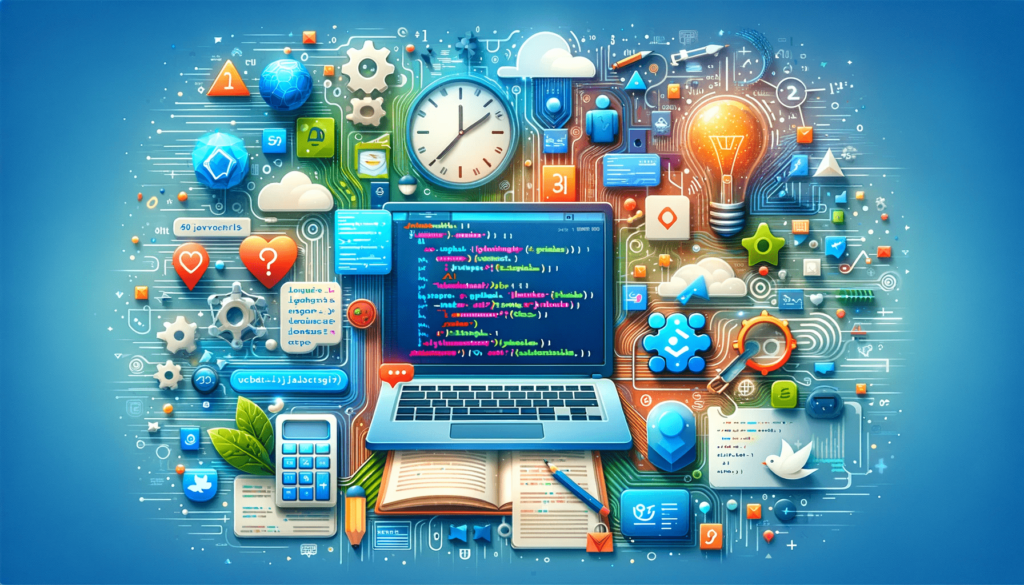Are you ready to unlock your potential with R Programming? Look no further – we’re here to guide you through the world of data analysis and show you how R Programming can make it simpler and more efficient.
R Programming is a powerful language that offers a wide range of benefits for data analysis. With its concise and expressive syntax, R Programming simplifies complex tasks and enhances the efficiency of data analysis. Whether you’re a beginner or an experienced programmer, learning R can open up a world of possibilities.
Key Takeaways:
- R Programming offers accelerated development time and improved code maintainability.
- Functional programming in R reduces the risk of errors and bugs.
- R is widely used in data-driven industries for extracting meaningful insights from data.
- Learning R can benefit various industries such as healthcare, fintech, and retail.
- Online courses like “Learn R” can help beginners become proficient in the language.
The Power of Functional Programming in R
Functional programming in R is a powerful approach that offers numerous benefits, including accelerated development time, improved code maintainability, and reduced risk of errors and bugs. By adopting functional programming principles, developers can create more robust and efficient code, resulting in faster and more reliable software solutions.
One of the key advantages of functional programming in R is its ability to simplify complex tasks and enhance code readability. The core principles of functional programming, such as pure functions, immutability, and higher-order functions, promote cleaner code architecture and make it easier to reason about the program’s behavior. This leads to improved code maintainability, as it becomes simpler to debug, modify, and extend the functionality of the codebase.
Moreover, functional programming in R enables developers to reduce the risk of errors and bugs. By enforcing immutability and avoiding side effects, functional code is less prone to unexpected behaviors and unintended consequences. This increases the reliability and stability of the software, ensuring that it performs as intended even in complex scenarios.
The Advantages of Functional Programming in R
Here are some key advantages of adopting functional programming in R:
- Accelerated development time: Functional programming encourages code reuse, modularity, and scalability, enabling developers to write concise and efficient code. This results in faster development cycles and quicker time-to-market for software solutions.
- Improved code maintainability: With its emphasis on immutability and pure functions, functional programming makes it easier to understand, modify, and debug the code. This leads to better code maintainability and reduces the effort required for future updates and enhancements.
- Reduced risk of errors and bugs: Functional programming minimizes the potential for unexpected behaviors and side effects, making the code less error-prone. It helps developers catch bugs early and promotes a more reliable and stable software system.
In summary, functional programming in R offers significant advantages in terms of accelerated development time, improved code maintainability, and reduced risk of errors and bugs. By adopting functional programming principles, developers can unlock the full potential of R programming and create more efficient, reliable, and scalable solutions.
| Advantages of Functional Programming in R |
|---|
| Accelerated development time |
| Improved code maintainability |
| Reduced risk of errors and bugs |
The Basics of R Programming
Ready to dive into R programming? In this section, we cover the basics of R programming and provide a comprehensive tutorial to help beginners get started. Whether you’re new to programming or transitioning from another language, R is a versatile language that offers powerful tools for data analysis and statistical modeling.
Let’s start with the essentials. R is an open-source programming language widely used in the field of data science and statistical analysis. Its syntax is intuitive and easy to learn, making it a popular choice for beginners. With R, you can perform complex data manipulations, visualize data, and create advanced statistical models.
To begin your journey with R, it’s important to understand the basic syntax and key concepts. R programs are composed of functions, which are reusable blocks of code that perform specific tasks. These functions can be combined to create scripts and perform complex operations.
Key Concepts in R Programming
Before diving into coding, let’s familiarize ourselves with some key concepts in R programming:
- Variables: In R, variables are used to store data. You can assign a value to a variable using the assignment operator “
=“. For example,x = 5assigns the value 5 to the variablex. - Data Types: R supports various data types, including numeric, character, logical, and factors. Understanding the appropriate data type for your variables is crucial for accurate data analysis.
- Vectors: Vectors are one-dimensional arrays that can store multiple values of the same data type. You can create a vector using the
c()function. For example,numbers = c(1, 2, 3, 4, 5)creates a numeric vector with the values 1, 2, 3, 4, and 5. - Data Frames: Data frames are two-dimensional structures that store tabular data. They are similar to a spreadsheet or a database table. You can create a data frame using the
data.frame()function.
By mastering these fundamental concepts, you’ll have a solid foundation for writing R code and exploring its vast capabilities. In the next sections, we’ll delve into more advanced topics and practical applications of R programming for data analysis and data science.
Complete Table
| Concept | Description |
|---|---|
| Variables | Used to store data |
| Data Types | Numeric, character, logical, factors |
| Vectors | One-dimensional arrays |
| Data Frames | Two-dimensional tabular data structures |
R Programming for Data Analysis
Data analysis is crucial in today’s data-driven industries. In this section, we explore how R programming can be utilized to extract meaningful insights from data.
One of the key advantages of using R programming for data analysis is its ability to handle large datasets efficiently. With its powerful functions and libraries, R allows data scientists to manipulate and analyze data with ease. Whether you need to clean and preprocess data, perform statistical analysis, or create visualizations, R provides a comprehensive set of tools to tackle various data analysis tasks.
Moreover, R programming offers a wide range of statistical techniques and models that can be applied to extract insights from complex datasets. From regression analysis to machine learning algorithms, R provides a versatile platform for data scientists to explore relationships, identify patterns, and make predictions based on data.
Additionally, R programming provides a seamless integration with other data analysis tools and programming languages. Its interoperability allows data scientists to leverage the strengths of different tools and combine them for more robust and comprehensive data analysis. Whether you need to import data from external sources, incorporate advanced analytics libraries, or export results to other platforms, R programming offers the flexibility to connect with various tools and technologies.
Example Table: Statistical Analysis Functions in R
| Function | Description |
|---|---|
| t.test() | Performs a t-test for comparing means between two groups |
| lm() | Fits a linear regression model to the data |
| cor() | Calculates the correlation coefficient between variables |
| anova() | Conducts analysis of variance for comparing group means |
In conclusion, R programming is a powerful tool for data analysis, offering a wide range of functions, libraries, and statistical techniques. With R, data scientists can extract meaningful insights from data and make informed decisions in today’s data-driven industries. Its flexibility, scalability, and integration capabilities make it a popular choice among professionals in fields such as healthcare, fintech, weather forecasting, research, retail, manufacturing, and social media. By mastering R programming, you can unlock the potential of data analysis and drive success in your industry.
R Programming for Data Science
Data science relies heavily on statistical modeling and analysis. In this section, we explore how R programming plays a crucial role in data science applications. R is a powerful language that offers a wide range of tools and packages specifically designed for statistical analysis and machine learning. Its concise and expressive syntax makes it easy to implement complex statistical models and perform advanced data manipulations.
R’s extensive collection of packages, such as “dplyr” and “tidyr,” provide efficient data wrangling capabilities, allowing data scientists to clean, transform, and reshape datasets with ease. Additionally, R offers robust visualization libraries like “ggplot2,” enabling users to create stunning data visualizations that aid in data exploration and presentation.
One of the key advantages of R programming for data science is its ability to handle large datasets efficiently. R supports parallel programming, allowing data scientists to perform computationally intensive tasks in a parallel manner, significantly reducing processing time. This scalability and performance make R an ideal choice for handling big data and conducting large-scale statistical analyses.
In summary, R programming is an essential tool for data science applications. Its capabilities in statistical modeling, data manipulation, and visualization make it the go-to language for data-driven industries. With its vast array of packages and resources, R simplifies the process of extracting meaningful insights from data and meets the demands of today’s data-driven industries.
| Benefits of R Programming for Data Science | R Programming Packages |
|---|---|
|
|
Related Article :
Industries Benefitting from R Programming
R programming is widely adopted across multiple industries, including healthcare, fintech, weather forecasting, research, retail, manufacturing, and social media. Let’s explore how R programming is transforming these sectors.
Healthcare
In the healthcare industry, R programming is helping professionals analyze large datasets to improve patient outcomes and streamline operations. R’s robust statistical analysis capabilities enable researchers to identify patterns, predict disease trends, and develop personalized treatment plans. From clinical trials to genomics research, R is revolutionizing healthcare by enabling evidence-based decision-making and precision medicine.
Fintech
In the world of finance, R programming is a game-changer. Banks, investment firms, and fintech startups leverage R’s data manipulation and visualization capabilities to gain insights into market trends, manage risk, and develop innovative financial products. With R, financial analysts can perform complex quantitative analyses, build predictive models, and create interactive dashboards to drive informed investment strategies and enhance overall financial performance.
Weather Forecasting
R programming plays a vital role in weather forecasting and climate modeling. Meteorologists and climate scientists use R’s powerful data processing and visualization tools to analyze weather patterns, model climate scenarios, and predict severe weather events. By harnessing R’s statistical modeling capabilities, weather forecasters can deliver accurate predictions, improving public safety and enabling proactive responses to extreme weather conditions.
Research
Researchers across various disciplines, such as social sciences, biology, and environmental science, rely on R programming for data analysis and visualization. R’s extensive library of statistical packages enables researchers to uncover trends, test hypotheses, and present their findings effectively. Whether studying social behavior, conducting experiments, or analyzing survey data, R provides researchers with the tools they need to gain valuable insights and advance their fields.
Retail, Manufacturing, and Social Media
From retail analytics to supply chain management, R programming is transforming the way businesses operate. Retailers leverage R’s predictive analytics capabilities to optimize pricing strategies, forecast demand, and personalize customer experiences. Manufacturers use R to improve efficiency, optimize production processes, and ensure quality control. Social media platforms rely on R’s data mining and sentiment analysis tools to gain insights into user behavior, enhance engagement, and deliver targeted content to users.
R programming’s versatility and powerful features make it a valuable tool across diverse industries. As the demand for data-driven insights continues to grow, mastering R programming opens up numerous opportunities for professionals seeking to unlock innovation and drive success in their respective industries.
| Industry | Benefits of R Programming |
|---|---|
| Healthcare | Improved patient outcomes, personalized treatment plans, evidence-based decision-making |
| Fintech | Data-driven investment strategies, risk management, financial product innovation |
| Weather Forecasting | Accurate predictions, proactive response to extreme weather conditions |
| Research | Data analysis, hypothesis testing, effective presentation of findings |
| Retail, Manufacturing, and Social Media | Predictive analytics, optimization, targeted marketing |
Learning R Programming on Your Own
Interested in learning R programming on your own? In this section, we explore the possibilities of self-learning and recommend online courses that can fast-track your journey to proficiency.
Learning a new programming language can be a daunting task, but with the right resources and dedication, it is entirely possible to become proficient in R programming within a month or less. Online courses offer a structured and comprehensive approach to learning, providing you with a solid foundation in R programming and guiding you through practical exercises and real-world examples.
One highly recommended online course for beginners is “Learn R.” This course covers all the essential aspects of R programming, starting from the basics and gradually building up to more advanced topics. It offers interactive lessons and hands-on exercises, allowing you to practice your skills and reinforce your learning. With “Learn R,” you can expect to gain a deep understanding of R programming and develop the necessary skills to apply it confidently in your data analysis and data science projects.
| Benefits of Online Courses for Learning R Programming |
|---|
| Structured and comprehensive curriculum |
| Interactive lessons with practical exercises |
| Flexible learning schedule |
| Access to expert instructors and support |
| Hands-on projects for real-world application |
By enrolling in an online course like “Learn R,” you can take advantage of these benefits and accelerate your learning process. Whether you are a beginner looking to start your journey in R programming or an experienced programmer seeking to expand your skillset, online courses offer a convenient and effective way to become proficient in R programming on your own terms.
Conclusion
In conclusion, R programming has the potential to unlock new opportunities in data analysis, data science, and statistical modeling. By learning R, you can harness the power of this versatile language to extract meaningful insights from data and meet the demands of today’s data-driven industries.
If you’re ready to embark on your R programming journey, look no further than DropoutDeveloper. As an online learning platform, we offer a treasure trove of free coding resources to help you get started. Whether you’re a beginner or looking to enhance your existing skills, our courses and tutorials can guide you through the intricacies of R programming.
With R’s functional programming capabilities, including pure functions, immutability, and higher-order functions, you can accelerate development time, improve code maintainability, reduce the risk of errors and bugs, and increase code reusability and modularity. R’s concise and expressive syntax makes it a popular choice for data-driven applications, data science projects, and statistical modeling.
From healthcare to fintech, weather forecasting to research, retail to manufacturing, and even social media, various industries benefit from the power of R programming. So why wait? Visit DropoutDeveloper today and unlock your potential with R programming.
FAQ
What are the benefits of functional programming in R?
Functional programming in R offers benefits such as accelerated development time, improved code maintainability and readability, reduced risk of errors and bugs, increased code reusability and modularity, scalability and performance, and simplified task parallelization.
What are the core principles of functional programming?
The core principles of functional programming include pure functions, immutability, and higher-order functions.
Why is R a language that excels in functional programming?
R provides concise and expressive syntax for handling common programming tasks, making it a language that excels in functional programming.
What industries can benefit from using R?
R is beneficial for a variety of industries, including healthcare, fintech, weather forecasting, research, retail, manufacturing, and social media.
Can I learn R programming on my own?
Yes, it is possible to learn R programming on your own. Online courses like “Learn R” can help beginners become proficient in the language within a month or less.







